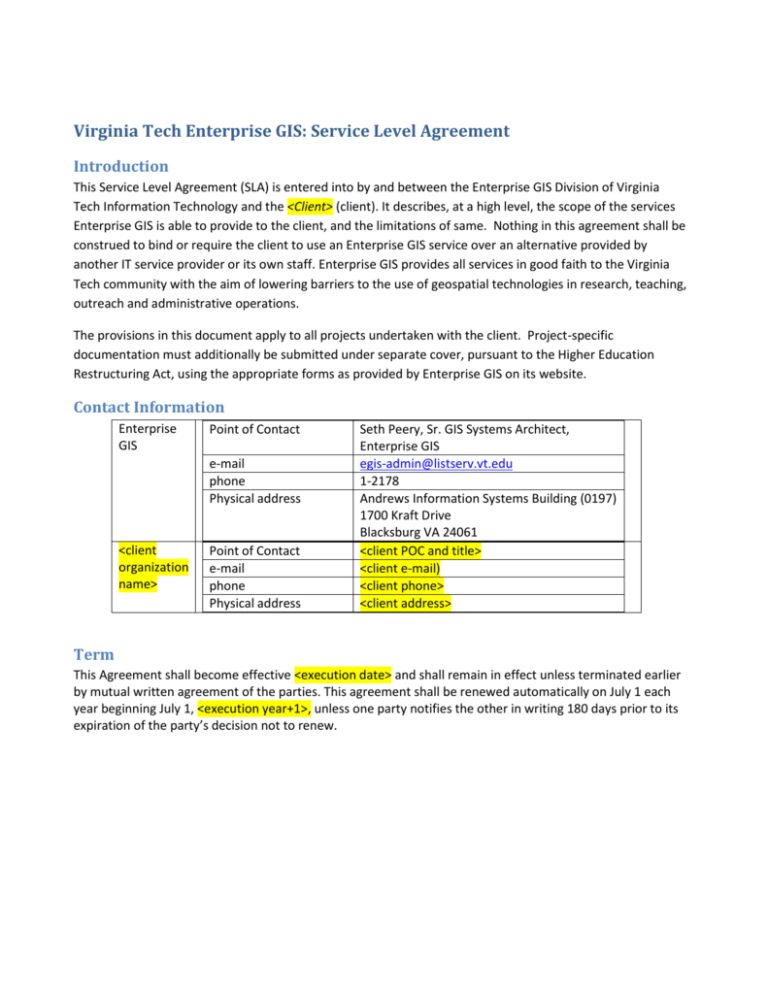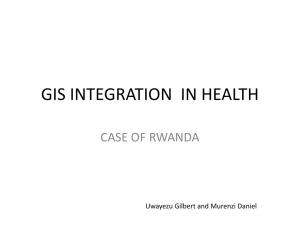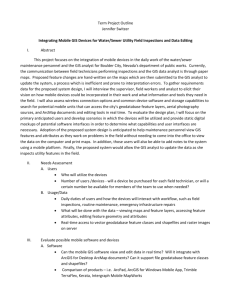Service Level Agreement - Enterprise GIS Research and
advertisement

Virginia Tech Enterprise GIS: Service Level Agreement Introduction This Service Level Agreement (SLA) is entered into by and between the Enterprise GIS Division of Virginia Tech Information Technology and the <Client> (client). It describes, at a high level, the scope of the services Enterprise GIS is able to provide to the client, and the limitations of same. Nothing in this agreement shall be construed to bind or require the client to use an Enterprise GIS service over an alternative provided by another IT service provider or its own staff. Enterprise GIS provides all services in good faith to the Virginia Tech community with the aim of lowering barriers to the use of geospatial technologies in research, teaching, outreach and administrative operations. The provisions in this document apply to all projects undertaken with the client. Project-specific documentation must additionally be submitted under separate cover, pursuant to the Higher Education Restructuring Act, using the appropriate forms as provided by Enterprise GIS on its website. Contact Information Enterprise GIS Point of Contact e-mail phone Physical address <client organization name> Point of Contact e-mail phone Physical address Seth Peery, Sr. GIS Systems Architect, Enterprise GIS egis-admin@listserv.vt.edu 1-2178 Andrews Information Systems Building (0197) 1700 Kraft Drive Blacksburg VA 24061 <client POC and title> <client e-mail) <client phone> <client address> Term This Agreement shall become effective <execution date> and shall remain in effect unless terminated earlier by mutual written agreement of the parties. This agreement shall be renewed automatically on July 1 each year beginning July 1, <execution year+1>, unless one party notifies the other in writing 180 days prior to its expiration of the party’s decision not to renew. Services Covered Under This Agreement 1. Enterprise GIS will provide a managed hosting environment for geospatial data. a. An instance of ESRI ArcSDE is available for clients to store vector data and related tables in geodatabase format. b. Multiple NAS and SAN resources are used to store filesystem data including shapefiles, map documents, imagery, and related data. 2. Enterprise GIS will provide a managed hosting environment for geospatial web services. a. Our current infrastructure is built using ESRI ArcGIS for Server. b. Clients will have the option to self-publish services or provide them to Enterprise GIS as service definitions for publication by the latter. 3. Enterprise GIS will provide a managed hosting environment for GIS web applications. a. Both HTTPS and HTTP will be supported (as separate virtual servers) b. The apache web server is preferred, but in special cases IIS will also be provided. c. Clients may self-publish applications to these virtual servers using WebDAV. d. Test and production environments are available for use within the context of the client’s change management procedure. e. PID/password authentication via CAS is available for HTTPS applications, and is the preferred mode of authentication, unless client applications do not support it. 4. Enterprise GIS may provide systems integration services to facilitate the interoperability of client systems with centrally managed GIS resources at the data, service or web tier, in cases where such integration supports an institutional priority or safety and security concern. 5. Enterprise GIS will, working with the Identity Management Services group as appropriate, manage, provision, deprovision and/or authorize client user accounts within the systems at the data, service and web tier used to support client applications. 6. Enterprise GIS will provide limited technical support to the client, to include a. Recommendations of best practices in the architecture and design of applications using the above infrastructure components. b. Troubleshooting of problems Enterprise GIS determines to be located within, or caused by, the above infrastructure components. c. Enterprise GIS will, in good faith, provide advice relating to client needs that go beyond this SLA as available and appropriate; however, all risk associated with such is to be borne by the client who is ultimately responsible for their own production applications. Support Structure a) VT Enterprise GIS will provide a secure and stable environment for the data, services, and applications covered under the scope of this agreement. 1) Enterprise GIS provides a “managed” environment for the hosting of geospatial data, services, and applications. As such, configuration details, such as firewall/security settings, user privileges, installed software packages, etc. shall be defined at the discretion of Enterprise GIS, informed by industry best practices and constrained by the requirements imposed by the Virginia Tech IT Security Office (ITSO). 2) The Enterprise GIS infrastructure is built on a base of limited computing resources that are shared with other clients. Client’s use of these resources (including disk storage, RAM, CPU and network bandwidth) will be necessarily constrained by the physical capacity of same at the time a request is made; although a best effort will be made by Enterprise GIS to allocate additional resources as needed, no guarantees are made that such resources can grow to meet client needs in a given timeframe. 3) Client requests for special access privileges, additional disk space, RAM, CPU or network utilization, non-standard configurations, and additional installed software will be considered, and may be supported, on a case-by-case basis, at Enterprise GIS’s sole discretion. However, requests of this nature may necessitate a revision of this agreement. 4) The specific implementation details of the infrastructure components provided by Enterprise GIS to support the “Services covered under this agreement” may change at any time. Clients will be notified of a change to the underlying infrastructure if it has the potential to create an interruption of service. 5) Functions such as systems administration, virtual machine and data storage provisioning, database administration, and identity management, as required to support the “Services covered under this agreement” may be provided by units of VT Information Technology outside of Enterprise GIS (“upstream resource providers”). a) Enterprise GIS will manage relationships and associated communications with upstream resource providers in support of the “Services covered under this agreement”. b) Clients should contact Enterprise GIS, as opposed to directly interacting with upstream resource providers, with any questions or problem reports pertaining to infrastructure components. c) Enterprise GIS will keep upstream resource providers informed of the resource requirements associated with the “Services covered under this agreement”, and the evolving needs of the system. 6) Provisions in this SLA have no binding effect on any of the upstream resource providers, as these are organizationally separate from Enterprise GIS. The timeliness or adequacy of resources provided to Enterprise GIS by the upstream resource providers is out of the control of Enterprise GIS and cannot be guaranteed as part of this agreement. 7) Enterprise GIS system computing resources are located in the IT Computing Facility, located in the Andrew Information System building at 1700 Pratt Drive, Blacksburg, Virginia, which provides a stable physical environment that is equipped with environmental controls, uninterruptible power supplies, and physical security systems. Enterprise GIS Responsibilities a) As detailed more fully in “Support Structure”, above, VT Enterprise GIS will provide a secure and stable environment for all data, services, and applications covered under the scope of this agreement. b) Enterprise GIS will provide the Client with up-to-date contact information. Currently, the listserv EGIS-ADMIN@LISTSERV.vt.edu forwards to all members of the Enterprise GIS team, and is preferable to the use of individual e-mail accounts for time-sensitive correspondence. c) Enterprise GIS will host the services covered under this agreement on a best-effort basis. a. No guarantee of uptime, on a percentage basis or otherwise, is expressed or implied by this SLA. b. No guarantee of sufficient disk storage, computing power, or network throughput to meet a specific use case is expressed or implied by this SLA. d) Enterprise GIS will monitor the uptime of services covered under this agreement. At minimum, the monitoring system will check for REST URLs to resolve without error. e) Enterprise GIS will attempt to restore service as soon as practical when an outage is detected by our monitoring system. See the section below “Planned and Unplanned Outages” for more details on response to downtime and maintenance events. f) Enterprise GIS will monitor the performance of the services covered under this agreement, and, subject to the limitations of the resources described in Support Structure, above, attempt to allocate sufficient physical server capacity to the services to meet mutually agreed-upon performance targets. a. The client may propose specific performance targets for services (response times for map render and GP tool execution), but must then discuss these with Enterprise GIS to arrive at a reasonable consensus regarding what level of performance can be supported by the current system. However, no guarantee beyond best effort is implied by such consensus agreement. b. Passive monitoring of “real” service utilization via on-host logging or off-host monitoring, or active simulation of load through stress testing, may be used by Enterprise GIS to arrive at a measured level of performance for each of the services covered under this agreement. c. Enterprise GIS will, upon identification of a performance deficiency, per the methods in (b), relative to the targets agreed upon in (a), work with its upstream resource providers (see “Support Structure”) to provision additional capacity. g) Enterprise GIS will prioritize the preservation client application function over the timely application of potentially disruptive application software upgrades, except in cases where a security risk is identified and a patch must be applied without delay. Operating system and application software upgrades deemed non-disruptive (no expected impact on client application function) may be rolled out in a test environment and then staged to production without notice, but clients will be notified prior to any upgrade that the Enterprise GIS team determines could disrupt the function of client applications, and the installation of such upgrades will proceed in coordination with the client to minimize downtime. Client Responsibilities a) The Client will retain ownership of the GIS data, services and applications hosted by Enterprise GIS. If access to these resources must be limited, the client must provide Enterprise GIS with a list of the individuals to be granted access. b) The Client must provide Enterprise GIS with contact information for at least one technical point of contact (POC) within their organization. These contact persons will be added to the Enterprise GIS listserv (VT-EGIS-USERS). c) The Client must install required GIS Client software on Client machines, and will be responsible for desktop support. d) The Client will provide project management documentation in accordance with the Restructuring Act and will maintain an up to date project plan and provide updates to Enterprise GIS when such updates affect the services provided by Enterprise GIS. e) Client may, at any time, schedule a quality assurance review as needed to ensure the services covered are meeting the client’s needs. f) The Client contact(s) will be responsible for forwarding (at their discretion) system maintenance notifications to stakeholders potentially impacted by a system maintenance event, who are not registered directly with the VT-EGIS-USERS list. Such stakeholders might include: contract software developers, other staff within their organizations, downstream consumers/users of web mapping applications and services. g) The client (or their contracted developers) will be responsible for the maintenance of application code. Enterprise GIS agrees to host this code, but not modify or troubleshoot it, unless expressly stated in Project Management documentation or in a revision to this document. h) If the client wishes to implement more detailed service “health” checks (e.g., exercising geoprocessing services with sample input data), client must provide Enterprise GIS with a Python test script to exercise said services. i) This SLA limits client use of shared infrastructure resources to reasonable levels of consumption (of disk, RAM, CPU, bandwidth) that do not unduly degrade the system performance of other users. Planned and Unplanned Outages 1. Planned maintenance for the enterprise GIS system will be conducted during the following established windows, unless an exceptional circumstance dictates the maintenance be performed at an alternate time: a. Monday – Saturday 3AM – 8AM and b. Sunday 3AM – 3PM 2. The VT-EGIS-USERS listserv will be notified via e-mail in advance of any planned outages that may cause an outage of over 15 minutes, or may extend past the normal maintenance windows. 3. Unplanned outages will be announced via the VT-EGIS-USERS listserv. Where possible, an ETA to resolution will be provided. 4. Enterprise GIS staff will attempt to perform maintenance and resolve outages with the aim of restoring normal function in a timely manner. Although our staffing structure precludes the ability to provide a guarantee of 24/7/365 staff availability on-call, as a general practice we try to ensure that at least one team member is available to respond to system-generated events. 5. Enterprise GIS staff will, at minimum, test for basic functionality (service availability) following a maintenance event or unplanned outage. Additionally, if the client provided scripts to automatically test service health, these will be run as well. Signatures IN WITNESS WHEROF, the parties have executed this Agreement: Client Enterprise GIS By______________________________________ By____________________________________ <Client POC> Seth Peery <Client Title> Sr. GIS Architect <Client Organization> Enterprise GIS Date: ____________________________________ Date: ________________________________By________________________ Brenda van Gelder Executive Director Converged Technologies for Security, Safety and Resilience Date: _______________________________







